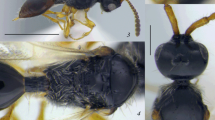Abstract
The non-spider arachnid diversity of the Great Nicobar Biosphere Reserve was surveyed for a period of 16 days, which resulted in finding five species of scorpions and one species of Amblypygi. The Reddyanus spp. and the Liocheles spp. were reported for the first time from the island. The earlier recorded species identity were rectified by examining voucher specimens.
Access this chapter
Tax calculation will be finalised at checkout
Purchases are for personal use only
Similar content being viewed by others
References
Chandra, K. 2017. Arachnida: Scorpions. In Faunal Diversity of Great Nicobar Biosphere Reserve, Conservation Area Series, 61, ed. K. Chandra, C. Raghunathan, and T. Mondal, 103–104. Kolkata: Zoological Survey of India.
Couzijn, H.W.C. 1981. Revision of the genus Heterometrus. Zoologische Verhandelingen 184: 1–196.
Kovařík, F. 2003. A review of the genus Isometrus Ehrenberg, 1828 with descriptions of four new species from Australia and Asia (Scorpiones, Scorpionidae). Euscorpius 10: 1–19.
———. 2004. A review of the genus Heterometrus Ehrenberg, 1828 with descriptions of seven new species (Scorpiones, Scorpionidae). Euscorpius—Occasional Publications in Scorpiology 15: 1–60.
———. 2007. A revision of the genus Hottentotta Birula, 1908, with descriptions of four new species (Scorpiones, Buthidae). Euscorpius—Occasional Publications in Scorpiology 2007 (58): 1–107.
Kovařík, F., G. Lowe, K.B. Ranawana, D. Hoferek, V.A. Sanjeewa Jayarathne, J. Plíšková, and F. Šťáhlavský. 2016. Scorpions of Sri Lanka (Arachnida, Scorpiones: Buthidae, Chaerilidae, Scorpionidae) with description of four new species of the genera Charmus Karsch, 1879 and Reddyanus Vachon, 1972 stat. n. Euscorpius—Occasional Publications in Scorpiology 220: 1–133.
Lourenço, W.R., B. Duhem, and E. Leguin. 2011. The genus Chaerilus Simon, 1877 (Scorpiones, Chaerilidae) in the Indian Ocean Islands and description of a new species. Euscorpius—Occasional Publications in Scorpiology 110: 1–8.
Monod, L. 2011. Taxonomic emendations in the genus Liocheles Sundevall, 1833 (Scorpiones, Liochelidae). Revue Suisse de Zoologie 118 (4): 723–758.
Pocock, R.I. 1900. Arachnida. The Fauna of British India, Including Ceylon and Burma, 279. London: W.T. Blandford.
Prendini, L., and S. Loria. 2020. Systematic revision of the Asian forest scorpions (Heterometrinae Simon, 1879), revised suprageneric classification of Scorpionidae Latreille, 1802, and revalidation of Rugodentidae Bastawade et al., 2005. Bulletin of the American Museum of Natural History 442: 480.
Sabaj, M.H. 2016. Standard Symbolic Codes for Institutional Resource Collections in Herpetology and Ichthyology. Version 6.5. Washington, DC: American Society of Ichthyologists and Herpetologists.
Tikader, B.K., and D.B. Bastawade. 1983. Scorpions (Scorpionida: Arachnida). In The Fauna of India, ed. Director, vol. 3, 671. Calcutta: Zoological Survey of India.
Acknowledgments
I thank the director, Zoological Survey of India and Dr. C. Sivaperuman, Scientist-E and Officer-in-Charge, ANRC, ZSI for the opportunity to explore the fauna of GNBR, through this expedition. I also thank Dr. S. Sambath, Scientist-E and Officer-in-Charge for necessary facilitation at ZSI, CZRC, Jabalpur. Thanks are also due to Dr. Basudev Tripathy (Scientist-E and O/C, Technical Section), Dr. A.K. Dubey (Scientist-D, ANRC, ZSI), Dr. G. Gokulakrishnan, Dr. Gautam, Dr. Amitava Majumdar, etc. for help in fieldwork and cooperation. My deep sense of gratitude to Dr. D.B. Bastawade for guidance and sincere thanks to Ms. Pragya Pandey for helping in taxonomic studies on scorpions.
Author information
Authors and Affiliations
Corresponding author
Editor information
Editors and Affiliations
Rights and permissions
Copyright information
© 2023 The Author(s), under exclusive license to Springer Nature Singapore Pte Ltd.
About this chapter
Cite this chapter
Mohapatra, P.P. (2023). Scorpion and Amblypygi Diversity of Great Nicobar Biosphere Reserve. In: Sivaperuman, C., Banerjee, D., Tripathy, B., Chandra, K. (eds) Faunal Ecology and Conservation of the Great Nicobar Biosphere Reserve. Springer, Singapore. https://doi.org/10.1007/978-981-19-5158-9_8
Download citation
DOI: https://doi.org/10.1007/978-981-19-5158-9_8
Published:
Publisher Name: Springer, Singapore
Print ISBN: 978-981-19-5157-2
Online ISBN: 978-981-19-5158-9
eBook Packages: Biomedical and Life SciencesBiomedical and Life Sciences (R0)




